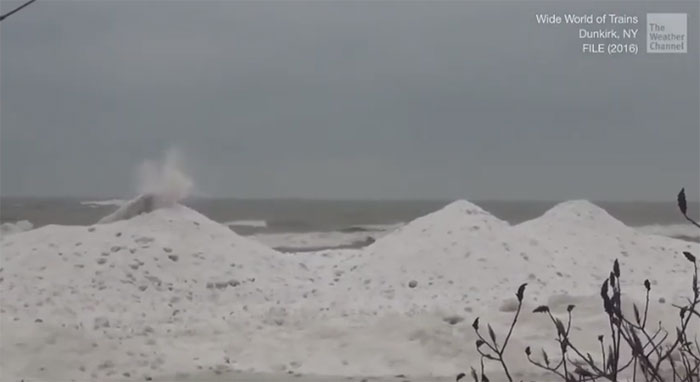'Ice volcano' erupts along the lake
Ice volcanoes form when large waves hit the edge of an ice shelf, which can be more than 8 meters high.

The condition for this phenomenon to occur is ice, high waves and low temperatures.
The National Weather Service (NWS) posted on social media a video of two erupting ice volcanoes along Lake Michigan , Michigan, on Feb. 16. "A great day to visit the lake and watch the waves interact with the ice , " wrote NWS.
Ice volcanoes often occur on the north shore of Lake Superior and Lake Michigan in the winter with a height from less than one meter to more than 8 meters. The three conditions for this phenomenon to occur are ice, high waves and low temperatures . Waves must be at least one meter high to create a volcanic ridge. When the volcano peak has formed, the waves continue to strike, pushing water through the gaps or grooves from below, creating eruptions like in the video.
Ice volcanoes are often located evenly along the banks of the lake but there are also isolated peaks. They are thought to form in areas where the ice is weak. Experts have never observed them in a state of eruption.
- "Ice volcano" phenomenon on the lake
- Impressive images of volcanoes on ice
- 'Mountain of destruction' is about to erupt
- Huge lava lake on Kilauea volcano
- Lake blue water at the bottom of the most active volcano in Hawaii
- Icelandic volcano eruption, European aviation alert
- Indonesian volcano erupts 5,000 meters
- Video: Iceland's most active volcano erupts
- 10 most frightening volcanoes in the world
- Japan: Shimmoe volcano erupts, column of ashes 5,000m high
- Mayon volcano in the Philippines erupts lava
- Mysterious lake color change
- Indonesia: Volcanic eruption, 6 people died
- The strange lake all year round boiled and fumed
 Is the magnetic North Pole shift dangerous to humanity?
Is the magnetic North Pole shift dangerous to humanity? Washington legalizes the recycling of human bodies into fertilizer
Washington legalizes the recycling of human bodies into fertilizer Lightning stone - the mysterious guest
Lightning stone - the mysterious guest Stunned by the mysterious sunset, strange appearance
Stunned by the mysterious sunset, strange appearance